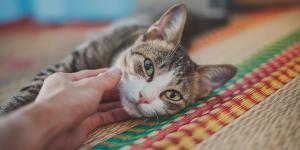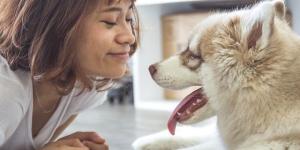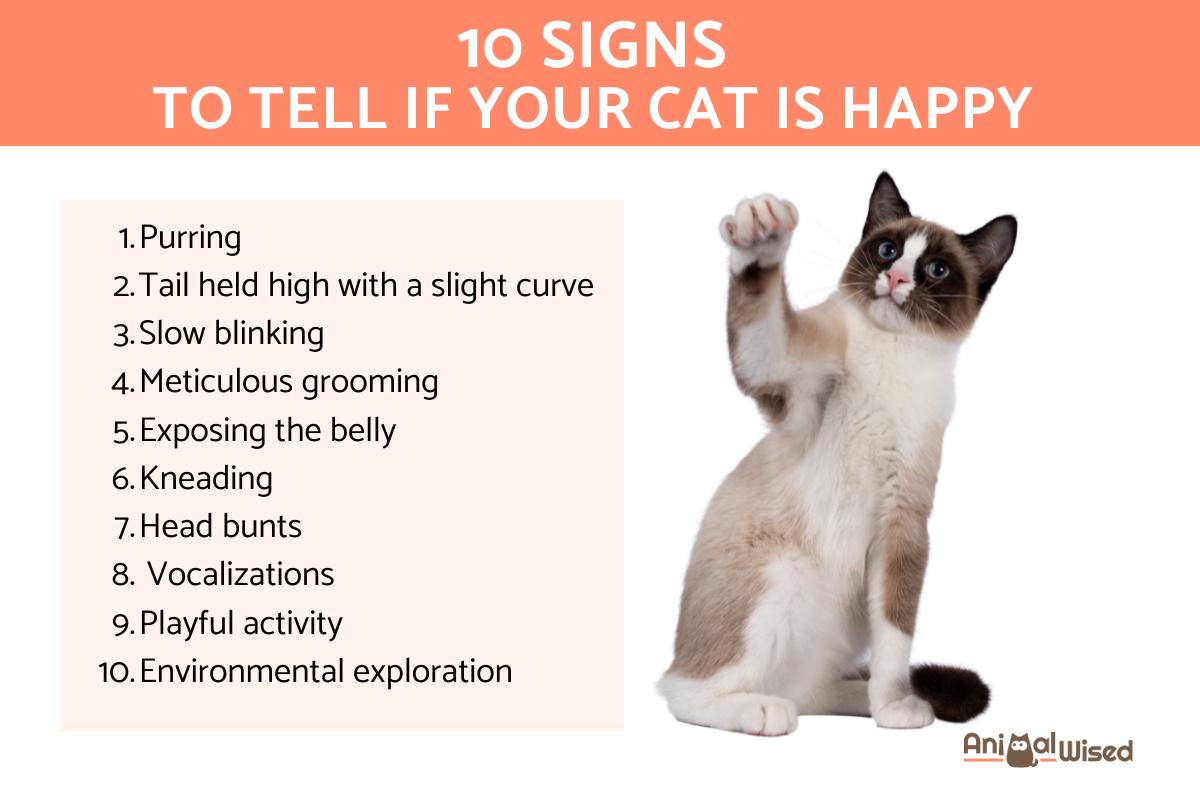How Can You Tell if Your Cat Is Happy?



See files for Cats
Cats are known for their independent and sometimes enigmatic nature, which can make it challenging for owners to really understand their feline friends' emotional states. However, cats are masters of subtle communication, often expressing themselves through body language and quiet vocalizations, and understanding whether your cat is happy is crucial for ensuring their well-being. Luckily, by paying attention to specific behaviors and physical cues, you can get a clear picture of your cat's happiness.
In this AnimalWised article, we will explore the top ten signs that indicate that your cat is happy, helping you ensure your cat is living their best life.
- Purring
- Tail position
- Slow blinking
- Meticulous grooming
- Exposing the belly
- Kneading
- Head bunts
- Vocalizations
- Playful activity
- Environmental exploration
Purring
Purring is one of the most recognizable signs of a happy cat. While cats can purr for various reasons, including when they are anxious or in pain, a steady, rhythmic purr often indicates contentment and relaxation.
While purring can occur in various situations, it's most commonly associated with feline contentment. Kittens begin purring as early as two days old while nursing from their mother. This purring is thought to communicate contentment and potentially stimulate milk letdown in the mother.
Throughout their lives, cats often purr during positive interactions like petting, playing, or mealtimes. The purr itself may act as a self-soothing mechanism, releasing endorphins that promote feelings of well-being. However, it's important to note that purring isn't always a guaranteed sign of happiness. Cats can also purr in stressful situations, such as during vet visits or when injured. Some researchers believe this may be a self-soothing mechanism to manage discomfort or anxiety.
Dive deeper into the fascinating world of feline communication in our next article.

Tail position
A cat's tail can convey a lot about its mood. A happy cat often has its tail held high with a slight curve at the tip, indicating confidence, contentment, and being open to social interaction. It's not trying to make itself appear smaller or blend into the background. This posture can be an invitation for petting or playtime, especially if accompanied by other friendly body language cues like head bumps or slow blinks.
The slight bend adds a touch of friendliness to the overall posture. A completely rigid, straight-up tail can sometimes be seen in alert or slightly aroused cats.
It is also important to note that a lowered tail tucked between the legs is often a sing of fear or anxiety.
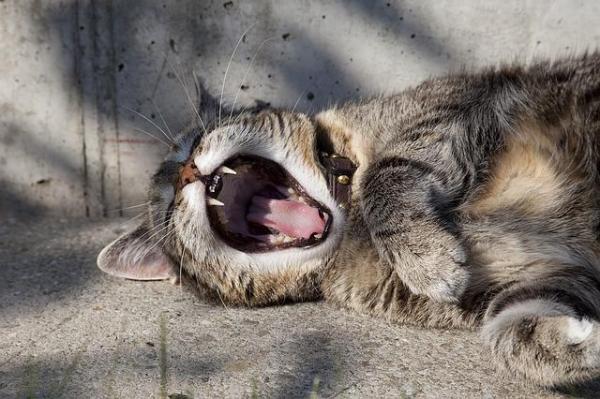
Slow blinking
Slow blinking in cats, also sometimes called a "kitty kiss" or "eye closing," is a fascinating and endearing form of feline communication that signifies contentment, trust and indicates that your cat feels comfortable around you.
Kittens use slow blinking during nursing to communicate comfort and satisfaction with their mother. This behavior can persist into adulthood, becoming a way for cats to express similar feelings of safety and contentment.
Recent research has shown that when a cat "slow blinks," both closing and opening the eyelids happen slowly. This is different from a normal cat blink, where the closing is quick, but the opening is slow. This difference is important because it suggests that slow blinking isn't just a reflex. Instead, it's a deliberate behavior that the cat chooses to do.
Interestingly, humans often intuitively understand slow blinking in cats. When we slow blink back at our feline companions, it can be interpreted as a sign of reciprocated trust and affection, further strengthening the bond between human and cat.
Discover the hidden signs your cat truly adores you in our next article.
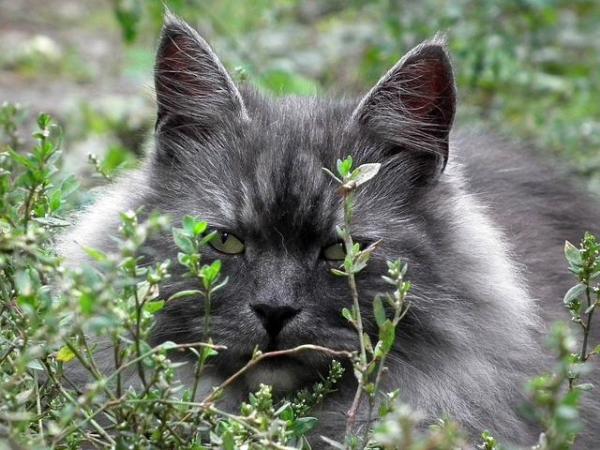
Meticulous grooming
Cats are meticulous groomers, spending up to a third of their day keeping themselves clean. This regular self-grooming is a good indicator of a healthy and content cat. It shows they're taking care of themselves and feeling comfortable in their environment.
Grooming isn't just about hygiene. Cats have scent glands on their heads and bodies. When you rub against your cat or they rub against you, you're actually exchanging scents. This is a way of marking familiarity and creating a shared group scent.
Cats also engage in "allogrooming," social grooming with trusted companions. This can be another cat, another animal, or even their favorite human. When your cat grooms you, it means they consider you part of their social circle and want to share this bonding behavior.
While regular grooming is a positive sign, abrupt or excessive grooming can indicate stress or anxiety. If you notice a sudden change in your cat's grooming habits, it's best to consult a veterinarian to rule out any underlying health issues.

Exposing the belly
A cat's belly is its most vulnerable area. It lacks the fur and muscle protection present on the rest of its body. Furthermore, this position restricts its ability to fight back or defend itself. In fact, in the wild, a cat wouldn't expose its belly unless it felt absolutely secure.
While not all cats enjoy belly rubs, a relaxed cat lying on its back with its belly exposed is a strong indicator of contentment. However, it is always best to let your cat initiate belly exposure and approach them cautiously for petting. Respect their boundaries to maintain the trust they're offering.
Kneading
Cats knead with their paws, often on soft surfaces or even on their owners. This behavior, reminiscent of kittenhood when they kneaded their mother's belly, indicates comfort and happiness. This repetitive kneading motion helps stimulate milk flow. While adult cats no longer need milk, the kneading action can be a comforting self-soothing behavior linked to positive memories from kittenhood.
The rhythmic kneading motion may have a calming effect on cats, similar to how kneading dough can be relaxing for humans. It could be a way for them to self-soothe and relieve anxiety.
It's important to note that while kneading is often linked to happiness, it can also be a sign of impatience or anticipation, especially if accompanied by a twitching tail. For instance, your cat might knead before mealtime out of excitement for food.
Explore more about the surprising origins of your cat's kneading in our next article.
Head bunts
A gentle head bump against your hand or leg is a feline greeting and a sign of affection. This behavior demonstrates a cat that feels comfortable and happy in your presence. It's a gentle and non-threatening way to initiate social interaction.
Cats have scent glands on their heads. When they head bunt you or another object, they're transferring their scent, essentially claiming you (or the object) as familiar and friendly territory.
Sometimes, a head bunt is a subtle way for your cat to get your attention. They might want petting, playtime, or simply some acknowledgement. Look for other cues to understand the full message. A relaxed posture with purring suggests affection, while a tense body and flattened ears might indicate anxiety.

Vocalizations
While the amount of vocalization varies between individual cats and breeds but, generally, happy cats often communicate through a range of meows, chirps, and trills. Cats are known for being relatively quiet creatures compared to dogs. However, their vocalizations, while subtler, are just as important in understanding their emotional state.
It is crucial to note that each cat has its own personality and vocal style. Some cats are naturally more talkative than others. However, generally, happy cats tend to produce vocalizations that are soft and pleasant to hear. These sounds are not urgent or distressed but rather a gentle form of communication.
Explore the meanings behind every meow, chirp, and purr in our next article.
Playful activity
A happy cat is an energetic cat. Playful behaviors like chasing toys, batting at objects, or bursts of energetic running (zoomies) are all signs of a well-stimulated and content cat.
This playful behavior is a crucial way for cats to fulfill their natural hunting instincts. By stalking, chasing, and pouncing on toys, they're mimicking the thrill of the hunt. This not only keeps them mentally stimulated but also provides essential exercise, promoting overall health and well-being.
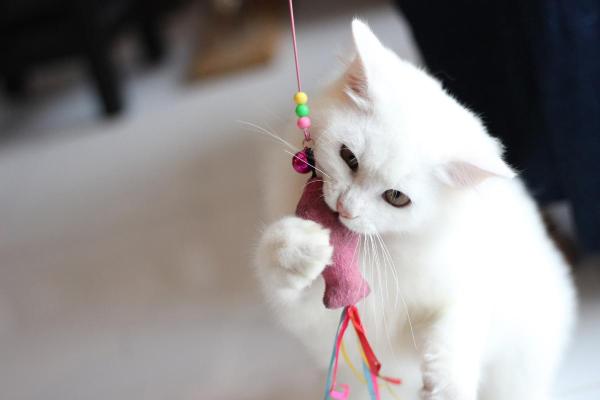
Environmental exploration
Cats are inherently curious creatures with a strong predatory instinct. However, curiosity is a hallmark of feline happiness. A cat that actively explores its environment, climbs furniture, or investigates windows demonstrates a healthy interest in the world around it.
Not only that, but exploration provides mental stimulation for cats, keeping them from boredom. It allows them to engage their senses and problem-solving skills as they navigate their surroundings. On the other hand, a bored cat is more likely to develop destructive behaviors.
Mental stimulation is key to keeping your cat happy. Explore some fun games you can play to keep their minds active in our next article.
If you want to read similar articles to How Can You Tell if Your Cat Is Happy?, we recommend you visit our Facts about the animal kingdom category.


